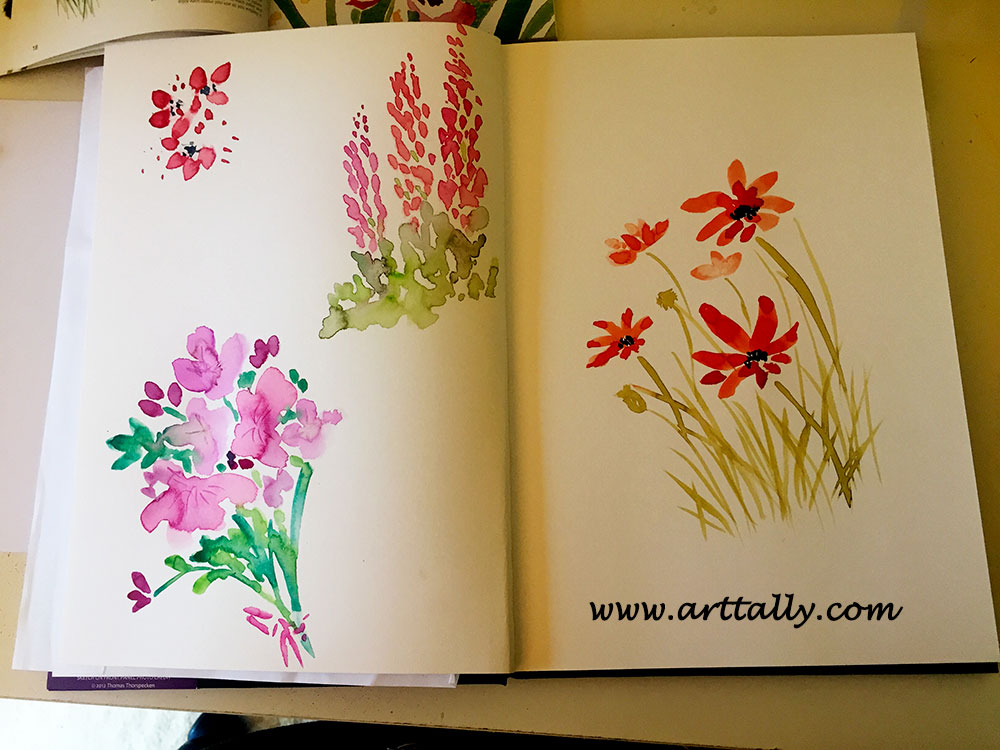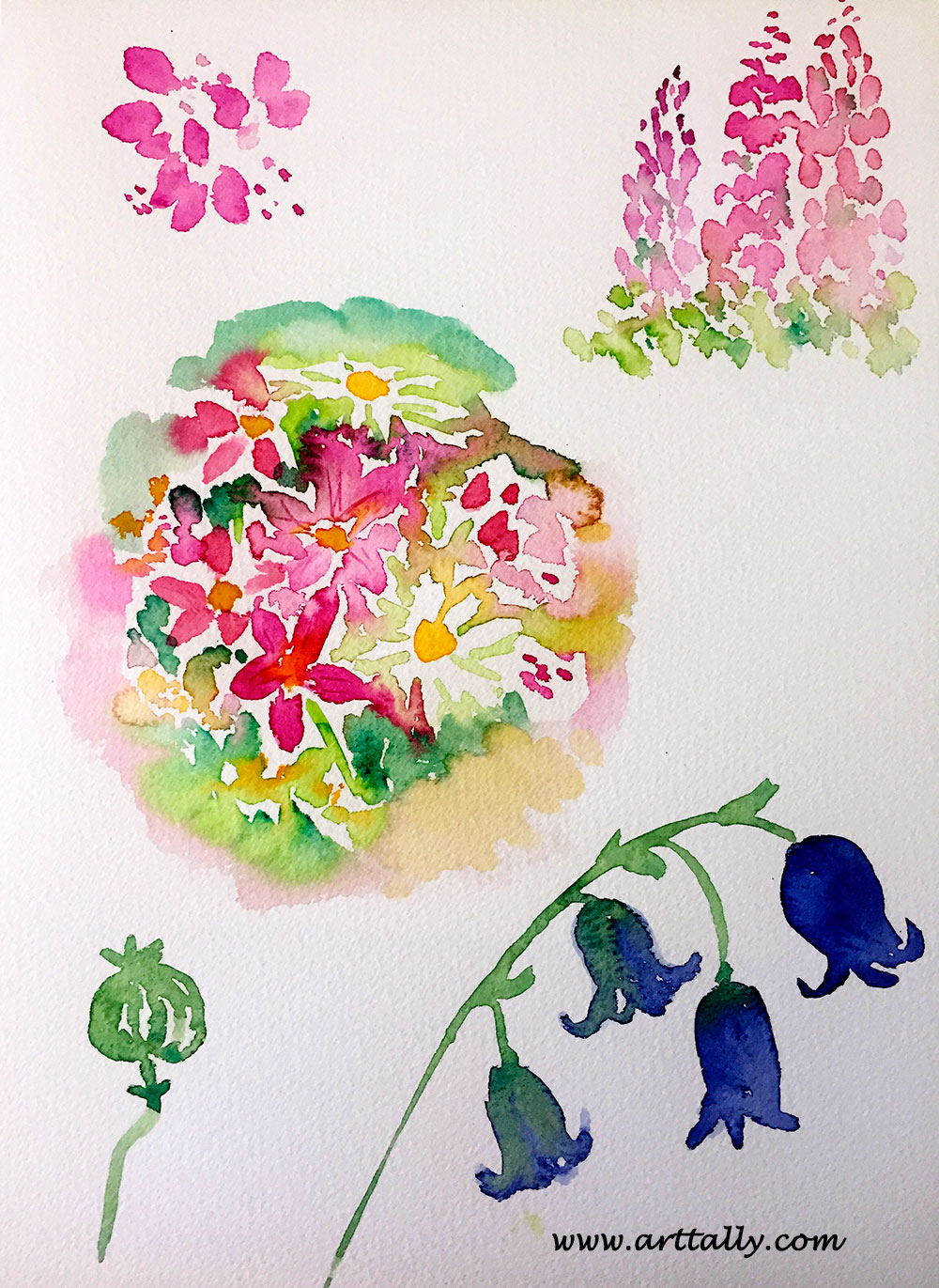30 minute flowers - the final 4 paintings
 I do love painting flowers, especially in watercolour. But I have to say that I am quite pleased at the prospect of painting something else next month.
I do love painting flowers, especially in watercolour. But I have to say that I am quite pleased at the prospect of painting something else next month.
These are the final four paintings for the month. The daisies are from Fiona Peart's book that inspired this whole series of 30 minute flowers . The others utilise some of the techniques that she uses but are simply from references that spoke to me.
If you would like to see the whole series together, head over here!
A posy is not complete without a bit of Baby's Breath
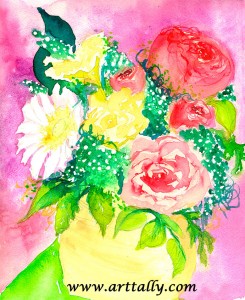 A posy is just not complete without a bit of Baby's Breath, is it?
A posy is just not complete without a bit of Baby's Breath, is it?
And what could be more fun than painting roses the Fiona Peart way?.... oh yes, a splashy pink and purple background of course....
30 minute flowers no 8
30 Minute flowers no 8 arttally
A jug of fresh chrysanthemums is always a joyous sight, isn't it?
This is my version of the ones from Fiona Peart's book (page 51).
If it is nearly Valentine's day, it has to be roses
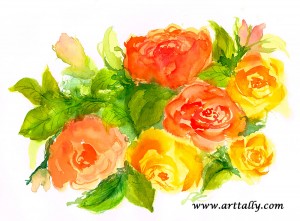 I have skipped over the first project in Fiona Peart's book because project number 2 (page 60) is roses. And if it is nearly Valentine's day then I guess it has to be roses, doesn't it?
I have skipped over the first project in Fiona Peart's book because project number 2 (page 60) is roses. And if it is nearly Valentine's day then I guess it has to be roses, doesn't it?
Wishing you a happy (and rose-filled) Valentine's Day.
30 minute flowers no 6
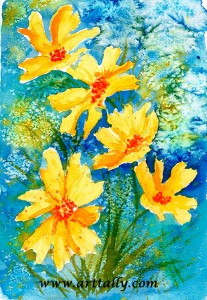 Sometimes painting the watercolour background can be even more fun than painting the subject itself.
Sometimes painting the watercolour background can be even more fun than painting the subject itself.
Number 6 in this series of 30 minute flowers uses salt to create some lovely texture behind the blossoms.
If you are playing along at home, it is from page 48 of Fiona Peart's book Painting Flowers in Watercolour!
Camellias in Watercolour
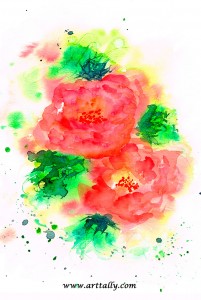 Camellias seem to be such generous flowers to me. All those layers and layers of velvety petals- such a picture of abundance.
Camellias seem to be such generous flowers to me. All those layers and layers of velvety petals- such a picture of abundance.
Painting camellias in watercolour in the style suggested by Fiona Peart (page 39 just in case you are following along at home...) is somewhat easier than it looks.
I wasn't so sure at first. Blobs and smudges it seemed to be. I sighed and persisted. I'm glad I did.
The thing is that this style of painting allows the viewer's imagination to make what it will of those blobs. Our brains are very good at identifying the bloom from those rough shapes. I love that.
Precise botanical detail is not offered by the image, but perhaps the essence of the bloom just might be.
30 minute watercolour poppies
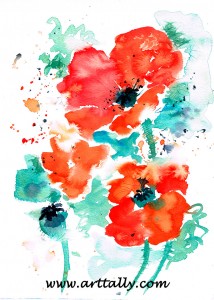 I love that you can finish a painting in well under 30 minutes. The actual painting time for these 30 minute watercolour poppies is considerably less than that. The rest of that time is spent watching the paint and water mingle on the paper - waiting for the right time to add something more.
I love that you can finish a painting in well under 30 minutes. The actual painting time for these 30 minute watercolour poppies is considerably less than that. The rest of that time is spent watching the paint and water mingle on the paper - waiting for the right time to add something more.
Painting wet in wet is a bit of a game of chance. I love it. You put water on the paper. You put paint on the paper. You sit back and see what happens.
It is part intentional painting part imagination - just like looking for shapes in clouds.
Once you find the shapes in the painting then it is a matter of patience.
If you add refining details while the paint is still too damp they will disappear into your shape.
If you wait too long those added details can sit on top of the painting like an afterthought.
The only thing to do is to practise, practise practise.
Rose bouquet
 This is number 3 in my series for the month - a rose bouquet. I hope it brightens your day!
This is number 3 in my series for the month - a rose bouquet. I hope it brightens your day!
Quick loose tulips in watercolour
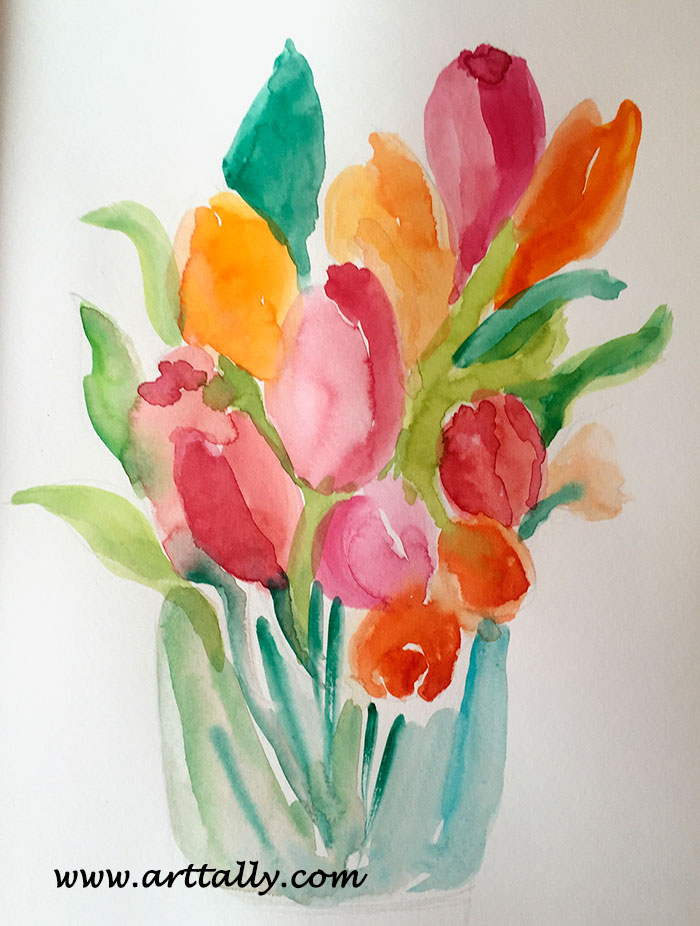 This is my version of Fiona Peart's Tulips on page 21 of Painting Flowers in Watercolour.
This is my version of Fiona Peart's Tulips on page 21 of Painting Flowers in Watercolour.
I love building up these images with lots of big loose splashy shapes - not too different from some of the tips I learned and loved from the last watercolour series. I think this is how you find your style. Not by trying too hard, but by painting a lot. Inevitably what you like sticks with you and creeps into your paintings no matter what you try and do. The things you love call to you.
I love splashy puddles of colour. I love the unpredictability of the water. And I love tulips.
What do you love?
Painting flowers in Watercolour with Fiona Peart
Painting Flowers in Watercolour with Fiona Peart
I have a rather lovely little book called Painting Flowers in Watercolour, by Fiona Peart. It is a part of the 30 Minute Artist series. Since I love flowers and am terribly impatient it only makes sense for this month's series to be 30 Minute Flowers.
The first steps in the book are about getting to know your materials and your palette. An early exercise was to do this by making a big splashy page of puddles of colour... you don't have to ask me twice!
30-minute-flowers-journal-page-no-1-w_arttally
Then we start painting flowers with watercolour by using easy brush marks and lots of negative painting to create simple shapes.
I have a Stillman and Birn Journal which is just divine. It is a hardbound journal and the paper is 270gsm. However, I had a bit of thing for hot press paper when I purchased it because I do love drawing on the silky surface with ink and coloured pencil etc. I used hot press paper for my Flower Face series and loved it. For a clean illustration the smooth surface is lovely. But if you want to use watercolour in a more traditional painterly way, the cold press surface is far more forgiving. So obviously now I want to trot off and buy a cold press Stillman and Birn journal....
30-minute-journal-page-on-cold-press-w_arttally
I repeated some of the paintings from the journal using cold press paper - not sure you can see the difference in the photos. The cold press paper handles more water, so I seem to have more cauliflowers appearing with smooth (hot press) paper than I do with the more textured cold press paper.
Using cold press paper, I had a go at Fiona's painting, Orchid (page 19 if you are following along in the book!). It's a bit different from the flowers I painted in my Watercolour Flowers series because there was no pencil drawing to begin with (eek - brave!)
Fiona advises building the painting up looking at the shapes like jigsaw puzzle pieces. Lots of fun. I decided this would be the first in the series. Can't wait to do the next one.
30-minute-flowers-no-1-w_arttally
I am really enjoying this book. My one frustration is its size, however. The paintings are so lovely and there are step by step instructions for the projects in the second half of the book that include thumbnail photos. Given that the book itself is about A5 size these thumbnails really are jolly tiny! Bigger ones would have made life much easier.
The book is still a delight, though. Big thumbs up.
Fast and loose watercolour no 8
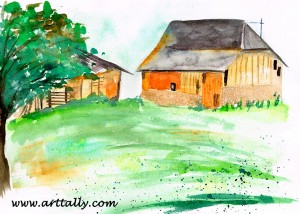 This painting is taken from the fourth lesson in the Udemy course on Fast and Loose Watercolour by Andy Walker. Using the techniques learned so far, I have painted from a photo reference provided by Andy.
This painting is taken from the fourth lesson in the Udemy course on Fast and Loose Watercolour by Andy Walker. Using the techniques learned so far, I have painted from a photo reference provided by Andy.
It is amazing how the techniques that resonate seep into your consciousness. I don't think that can happen quite so easily if you paint infrequently. However, since I have challenged myself to complete this series I think I am seeing the benefit - even if I am behind my anticipated schedule!
I can see things creeping in from various different lessons. Splattering from the last lesson, blocky shapes from the one prior and a bit of salt (because I can't help myself) for the stone masonry at the bottom of the building.
Expressive and spontaneous
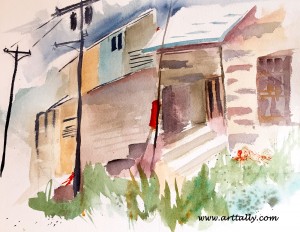 This painting is my version of Claude Croney's Captain Poole's Shed.
This painting is my version of Claude Croney's Captain Poole's Shed.
I can't say that it is my favourite sort of subject matter but I do love the loose style and the minimalist approach. It feels lovely to look for the big shapes of colour and key lines and place them in rather quickly. Feels like the quick gesture drawings that you do in figure drawing class.
I must have that sort of personality. I think it is impatience. That's what Claude seemed to think anyway:
"I prefer watercolor because of its unpredictability. The medium seems to fit my personality: I am impatient, and watercolor has a certain spontaneity and immediacy that appeals to me." Claude Croney
Texture in watercolour
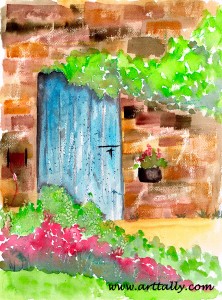 I'm finally back to my Fast and Loose watercolour series for this month. Number 7 comes from the third lesson in the Udemy course I am taking.
I'm finally back to my Fast and Loose watercolour series for this month. Number 7 comes from the third lesson in the Udemy course I am taking.
This time it is all about texture - so much fun. I used wax from a candle, kid's wax crayons, splatter from the brush, salt and a bit of scratching with a knife. I meant to use the edge of an old credit card to scrape out some more interesting marks but in all the excitement I forgot about it. Ah well... something to include next time.
Fast and Loose no 6
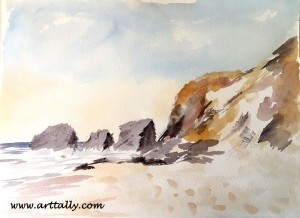 No 6 in my fast and loose series is another one of Edward Seago's paintings.
No 6 in my fast and loose series is another one of Edward Seago's paintings.
This one is my version of Seago's A Beach in Portugal. I love the way the minimalist style is so suited to the quiet, empty beach scene.
Makes me really want to go there... how about you?
Less is more...
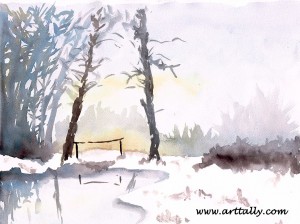 I have finally moved on to lesson 2 in my Udemy course - Watercolour - Fast and Loose. This one is all about minimalism.
I have finally moved on to lesson 2 in my Udemy course - Watercolour - Fast and Loose. This one is all about minimalism.
The master we are learning from in this lesson is Edward Seago. No 5 in my series, shown above, is my attempt at replicating the Edward Seago piece entitled The Pool in Winter.
Very few colours and very few marks, really, are required to paint this. Surprisingly tricky.
Less is more. But less is not exactly easier apparently.
Autumnal scene
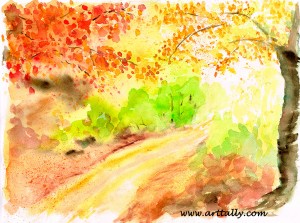 I can't resist an autumnal scene.
I can't resist an autumnal scene.
Just had to see how the unifying wash technique worked underneath my favourite trees and leaves.
Off to the beach... alone
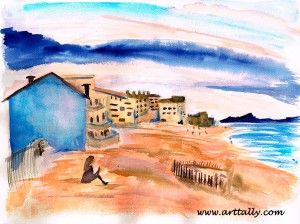 Today I am off to the beach... alone, so to speak.
Today I am off to the beach... alone, so to speak.
For this painting I began with a beach scene from a photo reference. Seemed apt, given the lone figure on the foreground and me painting her without the guidance from Frank Webb (like the first two paintings in this series) or Andy Walker, the Udemy course instructor.
I so enjoying beginning a painting with a pink wash yesterday I chose this scene because I thought it lent itself to the same approach.
Fast and Loose Watercolour no 2
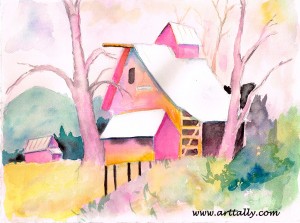 I am just loving the colours that Frank Webb chooses for some of his paintings. The second in my series of fast and loose watercolour for the month is my attempt at replicating Frank Webb's Sugar House Evening.
I am just loving the colours that Frank Webb chooses for some of his paintings. The second in my series of fast and loose watercolour for the month is my attempt at replicating Frank Webb's Sugar House Evening.
This painting is not part of the course I am doing as such. It is simply a painting I chose from Frank Webb's work that applies the same principle of an underlying wash that brings harmony to the whole image. In this case that wash was pink... what could be better?
Fast and loose!
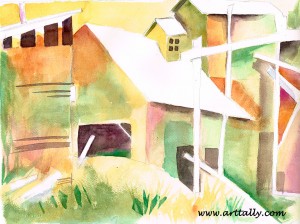 New year, new month, new series. They roll around fast, don't they?
New year, new month, new series. They roll around fast, don't they?
I am taking a Udemy course entitled 'Watercolour - Fast and Loose!' with Andy Walker. So far, I'm loving it. Since patience and precision are really not my thing I couldn't go past a course with a title like this. In each of the lessons, Andy chooses a watercolour impressionist and a key painting technique to be learned from the artist. So this month my series will be Fast and Loose Watercolours.
This first lesson is based on the work of Frank Webb. The painting technique offered is the approach of using a single colour wash over most of the painting as a very first step. This initial wash shows through all of the other colours and gives the whole painting a sort of glow.
The painting we are studying in this lesson is called 'Bill's Lumberyard'. Fast and Loose no 1 shown above is my attempt at replicating Frank Webb's painting. I love the abstract blocky shapes, and Frank Webb's slightly unexpected colour choices make my heart sing. Funnily enough, when I first saw the painting we were to emulate in this lesson I wasn't all that taken with it. Now I can't think of a single thing about it that I don't like.
Andy Walker's course makes the painting a simple process. Almost feels like a paint by numbers experience. Frank Webb did all the work in creating the beautiful image in the first place. Andy Walker breaks it down into easy painting layers. Having painted many a painting that concludes somewhat unsatisfactorily I can't tell you what a joy it is to complete the process and find that it all just works.
Try Twinkling H2Os for some festive bling in your artwork
I have had a small set of Twinkling H2Os watercolour paints in my stash for a while. If you have never come across them before you might want to check them out. They are cute little tiny pots of paint that 'twinkle'. They really do - a sort of metallic finish if you like.
Initially, I resisted buying them since you can add iridescent medium (which I obviously already have in my stash of course - this one) to any watercolour paints and you have 'twinkling' paint. I tried to tell myself that it was therefore unnecessary to have a separate set of sparkly paints.
I know. Madness. Conventional sensibility does not apply to art supplies. They are all necessary. Of course I need a separate set of twinkling paint.
There is one little trick you need to know to avoid disappointment with Twinkling H2Os. You need to open up all the little pots that you might use and give them a jolly good spritz of water and then let them sit for a minute or two before you begin. If you don't you will have a hard time getting enough paint on your brush and you will be misled into thinking the paint is weak and the colours insipid. They really aren't. They are glorious. But you do need enough water and time for the paint to absorb it in order to enjoy them.
Of course, iridescent medium works too, and you can control the amount of bling you are after by altering the quantity of medium that you add to the paint. The downside of the medium is that it can be a little smelly and you have the extra step of mixing it into the paint as you go.
For a bit of fun festive bling you can't go wrong with the instant gratification of the Twinkling H2Os. I'm loving them. I wish I had a few more colours. I hope Santa knows how good I have been...



